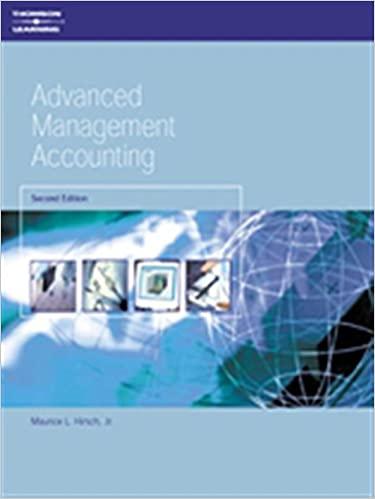Just the Question 10!!! Please!!!
1.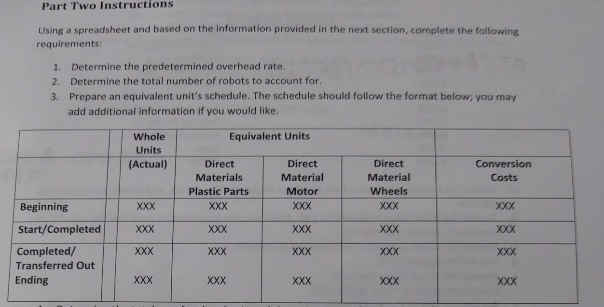
2.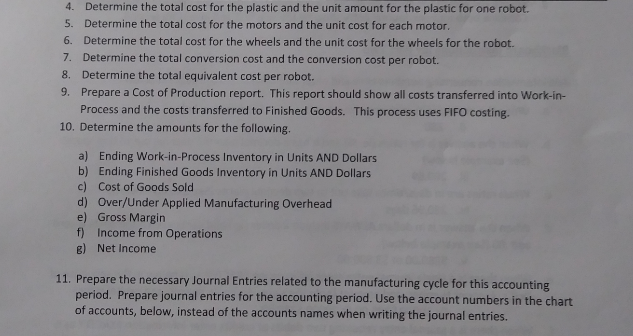
3.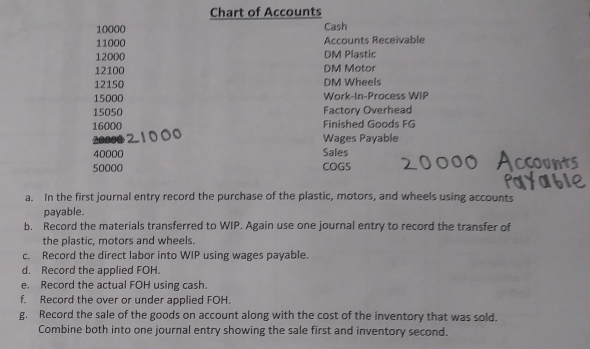
4.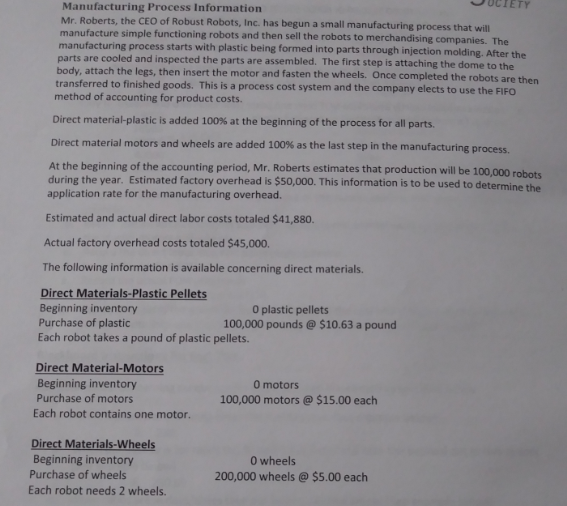
5.
6.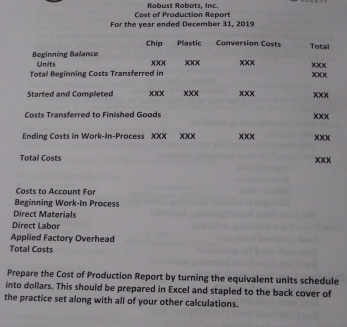
7.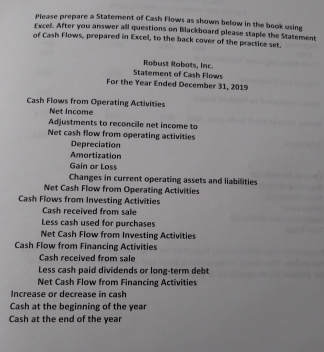
Those are the answers from previous question: 1-9 question.
Part 1.

Part 2.


Part 3.
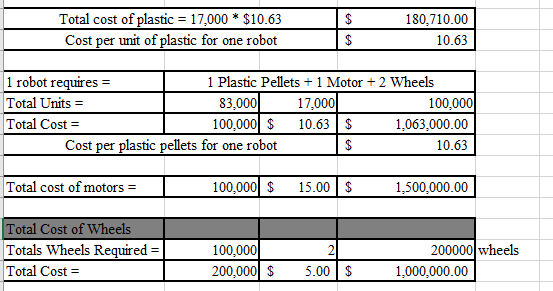
Part 4.

Part Two Instructions Using a spreadsheet and based on the information provided in the next section, complete the following requirements: 1. Determine the predetermined overhead rate. 2. Determine the total number of robots to account for. 3. Prepare an equivalent unit's schedule. The schedule should follow the format below. You may add additional information if you would like. Equivalent Units Whole Units (Actual) Conversion Costs Direct Materials Plastic Parts XXX Direct Material Motor XXX Direct Material Wheels xxx Beginning XXX XXX xxx XXX Start/Completed Completed/ Transferred Out Ending XXX XXX XXX XXX XXX XXX XXX XXX XXX XXX XXX 4. Determine the total cost for the plastic and the unit amount for the plastic for one robot. 5. Determine the total cost for the motors and the unit cost for each motor. 6. Determine the total cost for the wheels and the unit cost for the wheels for the robot. 7. Determine the total conversion cost and the conversion cost per robot. 8. Determine the total equivalent cost per robot. 9. Prepare a cost of Production report. This report should show all costs transferred into Work-in- Process and the costs transferred to Finished Goods. This process uses FIFO costing. 10. Determine the amounts for the following. a) Ending Work-in-Process Inventory in Units AND Dollars b) Ending Finished Goods Inventory in Units AND Dollars c) Cost of Goods Sold d) Over/Under Applied Manufacturing Overhead e) Gross Margin f) Income from Operations B) Net Income 11. Prepare the necessary Journal Entries related to the manufacturing cycle for this accounting period. Prepare journal entries for the accounting period. Use the account numbers in the chart of accounts, below, instead of the accounts names when writing the journal entries. 10000 11000 12000 12100 12150 15000 15050 16000 20000 21000 40000 50000 Chart of Accounts Cash Accounts Receivable DM Plastic DM Motor DM Wheels Work-In-Process WIP Factory Overhead Finished Goods FG Wages Payable Sales COGS 20000 Accounts Payable a. In the first journal entry record the purchase of the plastic, motors, and wheels using accounts payable. b. Record the materials transferred to WIP. Again use one journal entry to record the transfer of the plastic, motors and wheels. C. Record the direct labor into WIP using wages payable. d. Record the applied FOH. e. Record the actual FOH using cash. f. Record the over or under applied FOH. g. Record the sale of the goods on account along with the cost of the inventory that was sold. Combine both into one journal entry showing the sale first and inventory second. Manufacturing Process Information Mr. Roberts, the CEO of Robust Robots, Inc. has begun a small manufacturing process that will manufacture simple functioning robots and then sell the robots to merchandising companies. The manufacturing process starts with plastic being formed into parts through injection molding. After the parts are cooled and inspected the parts are assembled. The first step is attaching the dome to the body, attach the legs, then insert the motor and fasten the wheels. Once completed the robots are then transferred to finished goods. This is a process cost system and the company elects to use the FIFO method of accounting for product costs. Direct material plastic is added 100% at the beginning of the process for all parts Direct material motors and wheels are added 100% as the last step in the manufacturing process At the beginning of the accounting period, Mr. Roberts estimates that production will be 100.000 robots during the year. Estimated factory overhead is $50,000. This information is to be used to determine the application rate for the manufacturing overhead. Estimated and actual direct labor costs totaled $41,880 Actual factory overhead costs totaled $45,000. The following information is available concerning direct materials. Direct Materials-Plastic Pellets Beginning inventory O plastic pellets Purchase of plastic 100,000 pounds @ $10.63 a pound Each robot takes a pound of plastic pellets. Direct Material Motors Beginning inventory Purchase of motors Each robot contains one motor. O motors 100,000 motors @ $15.00 each Direct Materials-Wheels Beginning inventory Purchase of wheels Each robot needs 2 wheels. O wheels 200,000 wheels @ $5.00 each The Work-in-Process account has the following information: Ending work in process inventory has 17,000 units that are 100% complete as to plastic parts, 25% complete as to conversion costs and 0% complete as to motors and wheels. The Finished Goods account has the following Information: The finished goods inventory at January 1, 2019 had a balance of 2,000 robots at a cost of $140,000 and on December 31, 2019 had an ending balance of 3,000 robots. The selling price of the robot is $70.00. Selling and Administrative Costs totaled $100,000; tax rate is 35%. Robust Robots, Inc. Cast of Production Report For the year ended December 31, 2019 Plastic Conversion Casts Total Chip Beginning Balance Units XXX Total Beginning Costs Transferred in XXX Started and Completed XXX XXX xxx Costs Transferred to Finished Goods Ending Costs in Work-In-Process xxx xxx xxx Total Costs Costs to Account For Beginning Work in Process Direct Materials Direct Labor Applied Factory Overhead Total Costs Prepare the cost of Production Report by turning the equivalent units schedule into dollars. This should be prepared in Excel and stapled to the back cover of the practice set along with all of your other calculations. please prepare a statement of Cash Flows as shown below in the book sine cel After you answer all questions on Blackboard please staple the statement of Cash Flows, prepared in Excel, to the back cover of the practice set Robust Robots, Inc. Statement of Cash Flows For the Year Ended December 31, 2019 Cash Flows from Operating Activities Net Income Adjustments to reconcile net income to Net cash flow from operating activities Depreciation Amortization Gain or Loss Changes in current operating assets and liabilities Net Cash Flow from Operating Activities Cash Flows from Investing Activities Cash received from sale Less cash used for purchases Net Cash Flow from Investing Activities Cash Flow from Financing Activities Cash received from sale Less cash paid dividends or long-term debt Net Cash Flow from Financing Activities Increase or decrease in cash Cash at the beginning of the year Cash at the end of the year Overhead rate: $50,000 100,000 Total: $50,000/100,000 $0.50 Number of Robots to account for Beginning Inventory Units Started Total number of robots to account for 100,000 100,000 Whole Units Direct Materials Plastic Parts Beginning Inventory Units Started Completed Completed Transferred Out Ending Inventory 83,000 83,000 17,000 83,000 83,000 17,000 Direct Materials Motors Direct Materials Wheels Conversion Costs 83,000 83,000 83,000 83,000 0 83,000 83,000 4,250 $ Total cost of plastic = 17,000 * $10.63 Cost per unit of plastic for one robot 180,710.00 10.63 1 robot requires = 1 Plastic Pellets + 1 Motor + 2 Wheels Total Units = 83,000 17,000 100,000 Total Cost = 100,000 $ 10.63 $ 1,063,000.00 Cost per plastic pellets for one robot 10.63 obot Total cost of motors = 100,000 $ 15.00 $ 1,500,000.00 Total Cost of Wheels Totals Wheels Required = Total Cost = 100,000 200,000 $ 21 5.00 $ 200000 wheels 1,000,000.00 Total Equivalent Cost = Total Equivalent Cost = Plastic Parts Cost + Motors Cost + Wheels Cost | 3,563,000.00 $ Cost of Production Report Direct Material Cost: Overhead Cost: Total Cost of Production: $ $ 3,563,000.00 50,000.00 3,613,000.00 Part Two Instructions Using a spreadsheet and based on the information provided in the next section, complete the following requirements: 1. Determine the predetermined overhead rate. 2. Determine the total number of robots to account for. 3. Prepare an equivalent unit's schedule. The schedule should follow the format below. You may add additional information if you would like. Equivalent Units Whole Units (Actual) Conversion Costs Direct Materials Plastic Parts XXX Direct Material Motor XXX Direct Material Wheels xxx Beginning XXX XXX xxx XXX Start/Completed Completed/ Transferred Out Ending XXX XXX XXX XXX XXX XXX XXX XXX XXX XXX XXX 4. Determine the total cost for the plastic and the unit amount for the plastic for one robot. 5. Determine the total cost for the motors and the unit cost for each motor. 6. Determine the total cost for the wheels and the unit cost for the wheels for the robot. 7. Determine the total conversion cost and the conversion cost per robot. 8. Determine the total equivalent cost per robot. 9. Prepare a cost of Production report. This report should show all costs transferred into Work-in- Process and the costs transferred to Finished Goods. This process uses FIFO costing. 10. Determine the amounts for the following. a) Ending Work-in-Process Inventory in Units AND Dollars b) Ending Finished Goods Inventory in Units AND Dollars c) Cost of Goods Sold d) Over/Under Applied Manufacturing Overhead e) Gross Margin f) Income from Operations B) Net Income 11. Prepare the necessary Journal Entries related to the manufacturing cycle for this accounting period. Prepare journal entries for the accounting period. Use the account numbers in the chart of accounts, below, instead of the accounts names when writing the journal entries. 10000 11000 12000 12100 12150 15000 15050 16000 20000 21000 40000 50000 Chart of Accounts Cash Accounts Receivable DM Plastic DM Motor DM Wheels Work-In-Process WIP Factory Overhead Finished Goods FG Wages Payable Sales COGS 20000 Accounts Payable a. In the first journal entry record the purchase of the plastic, motors, and wheels using accounts payable. b. Record the materials transferred to WIP. Again use one journal entry to record the transfer of the plastic, motors and wheels. C. Record the direct labor into WIP using wages payable. d. Record the applied FOH. e. Record the actual FOH using cash. f. Record the over or under applied FOH. g. Record the sale of the goods on account along with the cost of the inventory that was sold. Combine both into one journal entry showing the sale first and inventory second. Manufacturing Process Information Mr. Roberts, the CEO of Robust Robots, Inc. has begun a small manufacturing process that will manufacture simple functioning robots and then sell the robots to merchandising companies. The manufacturing process starts with plastic being formed into parts through injection molding. After the parts are cooled and inspected the parts are assembled. The first step is attaching the dome to the body, attach the legs, then insert the motor and fasten the wheels. Once completed the robots are then transferred to finished goods. This is a process cost system and the company elects to use the FIFO method of accounting for product costs. Direct material plastic is added 100% at the beginning of the process for all parts Direct material motors and wheels are added 100% as the last step in the manufacturing process At the beginning of the accounting period, Mr. Roberts estimates that production will be 100.000 robots during the year. Estimated factory overhead is $50,000. This information is to be used to determine the application rate for the manufacturing overhead. Estimated and actual direct labor costs totaled $41,880 Actual factory overhead costs totaled $45,000. The following information is available concerning direct materials. Direct Materials-Plastic Pellets Beginning inventory O plastic pellets Purchase of plastic 100,000 pounds @ $10.63 a pound Each robot takes a pound of plastic pellets. Direct Material Motors Beginning inventory Purchase of motors Each robot contains one motor. O motors 100,000 motors @ $15.00 each Direct Materials-Wheels Beginning inventory Purchase of wheels Each robot needs 2 wheels. O wheels 200,000 wheels @ $5.00 each The Work-in-Process account has the following information: Ending work in process inventory has 17,000 units that are 100% complete as to plastic parts, 25% complete as to conversion costs and 0% complete as to motors and wheels. The Finished Goods account has the following Information: The finished goods inventory at January 1, 2019 had a balance of 2,000 robots at a cost of $140,000 and on December 31, 2019 had an ending balance of 3,000 robots. The selling price of the robot is $70.00. Selling and Administrative Costs totaled $100,000; tax rate is 35%. Robust Robots, Inc. Cast of Production Report For the year ended December 31, 2019 Plastic Conversion Casts Total Chip Beginning Balance Units XXX Total Beginning Costs Transferred in XXX Started and Completed XXX XXX xxx Costs Transferred to Finished Goods Ending Costs in Work-In-Process xxx xxx xxx Total Costs Costs to Account For Beginning Work in Process Direct Materials Direct Labor Applied Factory Overhead Total Costs Prepare the cost of Production Report by turning the equivalent units schedule into dollars. This should be prepared in Excel and stapled to the back cover of the practice set along with all of your other calculations. please prepare a statement of Cash Flows as shown below in the book sine cel After you answer all questions on Blackboard please staple the statement of Cash Flows, prepared in Excel, to the back cover of the practice set Robust Robots, Inc. Statement of Cash Flows For the Year Ended December 31, 2019 Cash Flows from Operating Activities Net Income Adjustments to reconcile net income to Net cash flow from operating activities Depreciation Amortization Gain or Loss Changes in current operating assets and liabilities Net Cash Flow from Operating Activities Cash Flows from Investing Activities Cash received from sale Less cash used for purchases Net Cash Flow from Investing Activities Cash Flow from Financing Activities Cash received from sale Less cash paid dividends or long-term debt Net Cash Flow from Financing Activities Increase or decrease in cash Cash at the beginning of the year Cash at the end of the year Overhead rate: $50,000 100,000 Total: $50,000/100,000 $0.50 Number of Robots to account for Beginning Inventory Units Started Total number of robots to account for 100,000 100,000 Whole Units Direct Materials Plastic Parts Beginning Inventory Units Started Completed Completed Transferred Out Ending Inventory 83,000 83,000 17,000 83,000 83,000 17,000 Direct Materials Motors Direct Materials Wheels Conversion Costs 83,000 83,000 83,000 83,000 0 83,000 83,000 4,250 $ Total cost of plastic = 17,000 * $10.63 Cost per unit of plastic for one robot 180,710.00 10.63 1 robot requires = 1 Plastic Pellets + 1 Motor + 2 Wheels Total Units = 83,000 17,000 100,000 Total Cost = 100,000 $ 10.63 $ 1,063,000.00 Cost per plastic pellets for one robot 10.63 obot Total cost of motors = 100,000 $ 15.00 $ 1,500,000.00 Total Cost of Wheels Totals Wheels Required = Total Cost = 100,000 200,000 $ 21 5.00 $ 200000 wheels 1,000,000.00 Total Equivalent Cost = Total Equivalent Cost = Plastic Parts Cost + Motors Cost + Wheels Cost | 3,563,000.00 $ Cost of Production Report Direct Material Cost: Overhead Cost: Total Cost of Production: $ $ 3,563,000.00 50,000.00 3,613,000.00


















